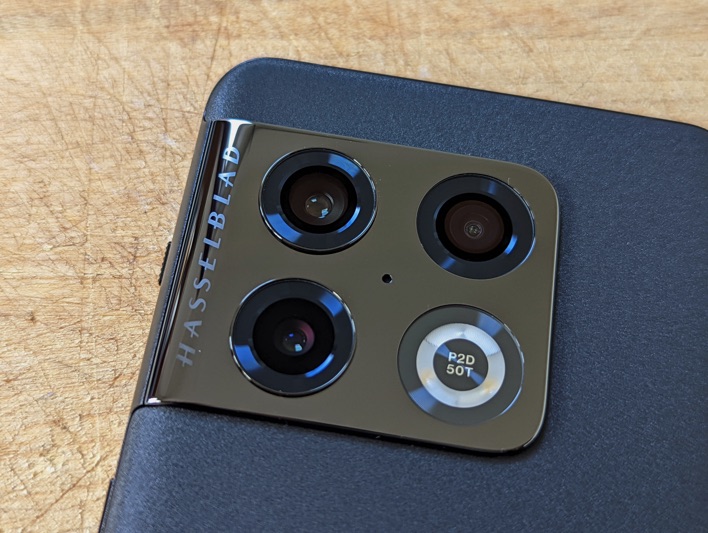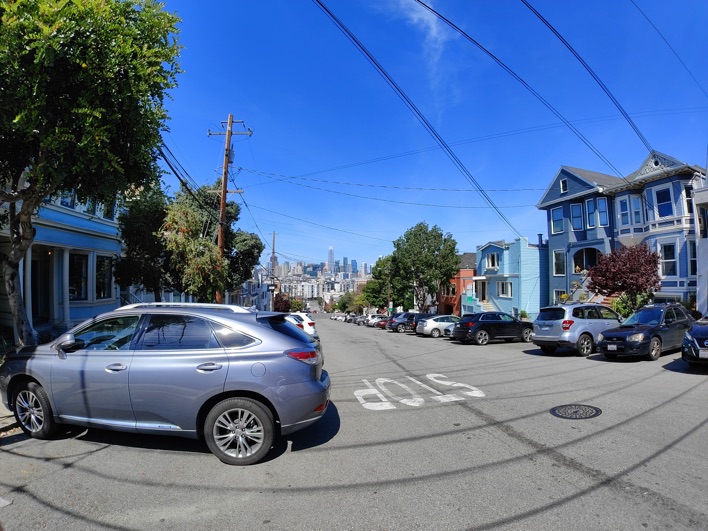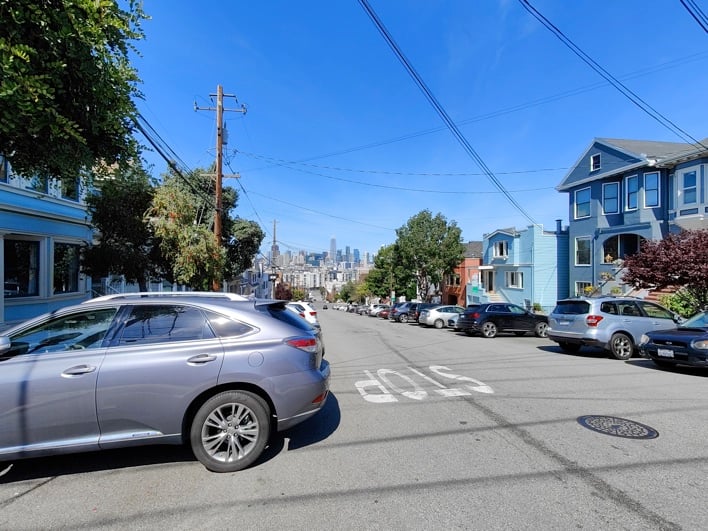OnePlus 10 Pro Review: A Solid Android Flagship With Innovative Cameras
OnePlus 10 Pro: It Ticks Most Of The Right Boxes
Then, in January, after years of simultaneously launching its flagship globally, the company released the OnePlus 10 Pro in China only with ColorOS 12 and 80W fast charging, but without a OnePlus 10 companion in tow. Fast forward to today, and that same OnePlus 10 Pro is now available to pre-order in the US for $899, with OxygenOS 12 and 65W fast charging. Oh, and there’s still no sign of a OnePlus 10 (standard).
Obviously, the OnePlus 10 Pro’s design and specs are familiar by now. So, what’s this phone like to use? Does it still feel like a OnePlus handset or is the experience more Oppo-like? And is it worth the $899 price tag? Read our full review to find out.
OnePlus 10 Pro Hardware And Design
Last year’s OnePlus 9 Pro was reasonably attractive, but between its Oppo Reno-inspired camera pod and the boring color options, it didn’t
really stand out. Just compare it to the company’s previous flagships.
Remember that stunning Ultramarine Blue OnePlus 8 Pro? The OnePlus 10 Pro addresses these shortcomings with a unique design and more exciting colorways, like Emerald
Forest and our review unit’s Volcanic Black.
Both hues feature satin glass backs with fine sparkles, just like their mineral namesakes, but the black finish actually looks more like OnePlus’s iconic sandstone. The frame is aluminum (polished green or anodized black) and rises to meet the camera module along the right side, but not along the top. Basically, this design is similar to what Samsung popularized with the Galaxy S21 series, but just in one dimension.
Both hues feature satin glass backs with fine sparkles, just like their mineral namesakes, but the black finish actually looks more like OnePlus’s iconic sandstone. The frame is aluminum (polished green or anodized black) and rises to meet the camera module along the right side, but not along the top. Basically, this design is similar to what Samsung popularized with the Galaxy S21 series, but just in one dimension.
The black ceramic camera pod is almost square, and sports Hasselblad’s
brand stenciled along the edge that blends into the OnePlus 10 Pro’s
frame. It contains four decorative circles arranged in a square – one for
each shooter (48MP main, 50MP ultrawide, and 8MP telephoto), and one for
the circular dual-LED flash. The circles for the main and telephoto
cameras are slightly raised, while the other two are flush.
Oh, and if you’re curious what that P2D 50T text means at the center of the flash module, we’ve got you covered. According to OnePlus, the P stands for “phone”, 2D for “second-generation Hasselblad camera”, and 50T for “50MP triple-shooters”. Glad we cleared that up. The camera module also includes a third mic, right in the middle. In all, this camera pod really gives the OnePlus 10 Pro a unique and pleasant vibe.
Oh, and if you’re curious what that P2D 50T text means at the center of the flash module, we’ve got you covered. According to OnePlus, the P stands for “phone”, 2D for “second-generation Hasselblad camera”, and 50T for “50MP triple-shooters”. Glad we cleared that up. The camera module also includes a third mic, right in the middle. In all, this camera pod really gives the OnePlus 10 Pro a unique and pleasant vibe.
The rest of this phone’s design is standard OnePlus. You get a 6.7-inch
AMOLED display with curved edges, minimal bezels, and a punch hole (for
the 32MP selfie camera) in the top left corner. There’s also the earpiece,
which doubles as one of the two speakers. We’re not big fans of waterfall
screens, but this design is more subtle and, together with the curved sides of the rear
glass, makes the OnePlus 10 Pro supremely comfortable to hold.
Build quality is top notch, as you’d expect. It’s also water and dust resistant, though only T-Mobile’s variant earns an IP68 rating. Along the edges, you’ll find OnePlus’ signature alert slider and the power / lock key on the right side, and the volume rocker on the left. The main speaker, USB Type-C port (USB 3.1), primary mic, and (single) SIM tray are mounted on the bottom edge, while the secondary mic lives on top.
Build quality is top notch, as you’d expect. It’s also water and dust resistant, though only T-Mobile’s variant earns an IP68 rating. Along the edges, you’ll find OnePlus’ signature alert slider and the power / lock key on the right side, and the volume rocker on the left. The main speaker, USB Type-C port (USB 3.1), primary mic, and (single) SIM tray are mounted on the bottom edge, while the secondary mic lives on top.
Take a look at our OnePlus 10 Pro unboxing video before we continue...
OnePlus 10 Pro Specs And Features
| Processing and 5G Platform | Qualcomm
Snapdragon 8 Gen 1 + integrated Snapdragon X65 5G Modem |
| Display | 6.7"
QHD+ LTPO AMOLED, 3216x1440
resolution, 1-120Hz, HDR10+ |
| Memory | 8GB LPDDR5 |
| Storage | 128GB
UFS 3.1 |
| Rear-Facing Cameras | 48MP f/1.8 Main OIS, PDAF - 50MP f/2.2 150º Ultra-Wide - 8MP f/2.4 3x Telephoto OIS, AF |
| Front-Facing Cameras | 32MP
f/2.4 |
| Video Recording | Up to 8k @ 24fps, 4K @ 60fps, 1080p @ 120fps, 1080p slow-mo |
| Battery | 5000
mAh, 65W wired charging, 50W wireless charging |
| OS | Android 12 With
OxygenOS 12 |
| Dimensions | 163 x 73.9 x 8.6mm |
| Weight | 200 grams |
| Connectivity | 802.11ax
Wi-Fi 6, Bluetooth 5.2+LE, NFC, USB-C, LTE, 5G |
| Colors | Volcanic
Black, Emerald Forest |
| Pricing | Find the OnePlus 10 Pro @ Amazon, Starting at $899 |
OnePlus 10 Pro Display Quality
The OnePlus 10 Pro packs the same display as the Oppo Find X5 Pro – a
6.7-inch 10-bit Quad HD+ (3216 × 1440 pixels, 525ppi, HDR10+)
second-generation LTPO AMOLED panel with a 20.1:9 aspect ratio and a
1-120Hz variable refresh rate. It’s a gorgeous screen, with vibrant
colors, deep blacks, wide viewing angles, and minimal bezels. Plus, at
1300 nits peak brightness, it’s easy to read in direct sunlight.
While not fond of displays with curved edges, the effect is pretty mild here, and it allows this handset to be slightly narrower and easier to grip. Otherwise, we have no complaints – this screen is gorgeous and flagship worthy.
OnePlus 10 Pro Camera Performance And Image Quality
At first glance, the OnePlus 10 Pro’s shooters don’t appear to be very
different from the OnePlus 9 Pro’s. Sure, that questionable 2MP monochrome
camera is gone, along with the laser AF module, but the 48MP main sensor
and 8MP telephoto lens remain the same. And indeed, the biggest change is
with the 50MP ultrawide shooter, which gets a sensor downgrade, but a lens upgrade
to a 150-degree FoV.
Spec-wise, the OnePlus 10 Pro features a 48MP f/1.8 1.12-micron main shooter (1/1.43-inch Sony IMX789) with omni-directional PDAF and OIS, a 50MP f/2.2 0.64-micron 150-degree ultrawide (Samsung ISOCELL JN1) without AF, and an 8MP f/2.4 1.0-micron 3.3x telephoto with AF and OIS. In front, the 32MP f/2.4 0.8-micron selfie camera (Sony IMX615) is an upgrade over last year’s 16MP setup (Sony IMX 471).
Spec-wise, the OnePlus 10 Pro features a 48MP f/1.8 1.12-micron main shooter (1/1.43-inch Sony IMX789) with omni-directional PDAF and OIS, a 50MP f/2.2 0.64-micron 150-degree ultrawide (Samsung ISOCELL JN1) without AF, and an 8MP f/2.4 1.0-micron 3.3x telephoto with AF and OIS. In front, the 32MP f/2.4 0.8-micron selfie camera (Sony IMX615) is an upgrade over last year’s 16MP setup (Sony IMX 471).
Obviously, switching the 50MP ultrawide sensor from Sony’s large
(1/1.56-inch, 1.0-micron pixels) IMX766 to Samsung’s small (1/2.76-inch,
0.64-micron pixels) ISOCELL JN1 results in some compromises – especially
when it comes to low-light performance – as we’ll discuss shortly. Then
again, it enables the OnePlus 10 Pro’s new party trick: hyper-wide and
fish-eye images, thanks to that 150-degree lens.
Photo modes include Portrait, Night, Pro (manual), 48/50MP high-res, Panorama, Long Exposure, Tilt-Shift, and 150-degree Ultra-Wide (with a fish-eye option). By default, the ultrawide shoots with a 110-degree FoV. Night mode supports all four shooters, and Pro mode works on all three rear cameras. Like Apple’s multi-frame ProRAW, OnePlus’ new 12-bit RAW+ option combines the benefits of RAW and computational photography.
Photo modes include Portrait, Night, Pro (manual), 48/50MP high-res, Panorama, Long Exposure, Tilt-Shift, and 150-degree Ultra-Wide (with a fish-eye option). By default, the ultrawide shoots with a 110-degree FoV. Night mode supports all four shooters, and Pro mode works on all three rear cameras. Like Apple’s multi-frame ProRAW, OnePlus’ new 12-bit RAW+ option combines the benefits of RAW and computational photography.
Besides pro mode and its RAW+ option, Hasselblad specific features include “Master Style” filters (Serenity, Radiance, and Emerald) and XPAN mode, which replicates the company’s iconic 45mm shooting experience with a 65:24 aspect ratio. It’s also worth noting that there’s no dedicated macro mode anymore, since the new 150-degree ultrawide lacks autofocus, but you can use the telephoto for closeup shots instead.
On the video front, all three rear shooters capture stabilized video (with stereo audio) at up to 1080p 60fps and 4k 30fps. The main and telephoto cameras also support 4k 60fps, and the main shooter even records video at 4k 120fps and 8k 24fps. Selfie videos max out at just 1080p 30fps, which isn’t competitive. This is a common limitation on flagships from BBK Electronics and Xiaomi, and frankly it’s disappointing.
Video modes include Ultra Stable (ultrawide, 1080p 60fps only), movie /
pro (manual, 21:9, 4k 30fps), Slow Motion (main, 1080p 240fps and 720p
480fps), Time Lapse (4k 30fps), and Dual View (main plus selfie, 1080p
30fps). The camera interface is similar to last year’s, complete with that
Hasselblad-inspired orange shutter button. It lacks a 2x zoom preset,
though, which is slightly annoying. Otherwise, we’re happy with it.
The OnePlus 10 Pro takes beautiful pictures. We've been quite fond of Oppo’s camera tuning and color science ever since we reviewed the Find X2 Pro, and it’s clear that the OnePlus 10 Pro benefits from Oppo’s imaging expertise. Hasselblad’s role is less obvious here, but putting the OnePlus 10 Pro and Find X5 Pro shooters side-by-side, the imaging flavor is unmistakably Oppo – and it’s absolutely delicious.
The OnePlus 10 Pro takes beautiful pictures. We've been quite fond of Oppo’s camera tuning and color science ever since we reviewed the Find X2 Pro, and it’s clear that the OnePlus 10 Pro benefits from Oppo’s imaging expertise. Hasselblad’s role is less obvious here, but putting the OnePlus 10 Pro and Find X5 Pro shooters side-by-side, the imaging flavor is unmistakably Oppo – and it’s absolutely delicious.
Overall, photos are crisp with accurate exposure and superb colors. Both the 48MP main and 50MP ultrawide cameras use 4-to-1 pixel binning by default for better dynamic range and low-light performance, resulting in 12MP and 12.5MP images (2.24 and 1.28-micron pixels). Still, you can’t beat physics, and the ultrawide’s new, smaller sensor simply doesn’t live up to the quality of last year’s larger sensor.
That’s unfortunate, because that 150-degree lens is a lot of fun. On
the plus side, the telephoto lens benefits from an improved zooming
algorithm for clearer shots up to 30x – though we suggest you stick to 5x
for great results and 10x for pictures that are still usable. Selfies are
lovely too, but strangely OnePlus isn’t binning pixels to create even
better 8MP photos. Video performance is pretty decent, but not
spectacular.
In all, we’re impressed with the OnePlus 10 Pro’s shooters. Ultrawide aside, this camera system is a solid improvement over the OnePlus 9 Pro’s. Just look at those colors! And for the first time ever, we feel like OnePlus is finally nipping at the heels of Apple, Samsung, and Google when it comes to imaging. That’s no small feat.
Next up: audio, performance, and battery life...


























